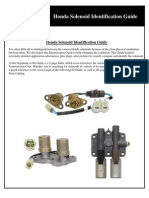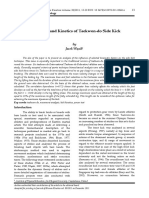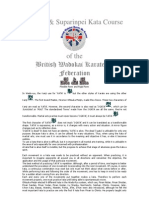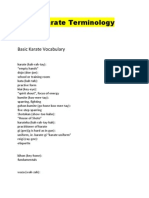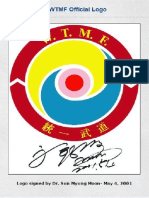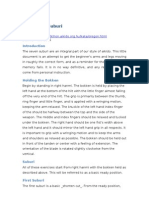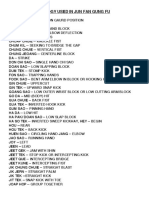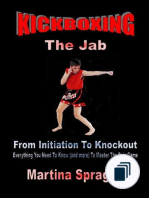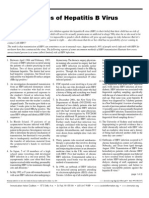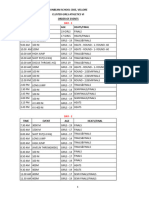Naihanchi Mook Jong PDF
Naihanchi Mook Jong PDF
Uploaded by
wakasensei99Copyright:
Available Formats
Naihanchi Mook Jong PDF
Naihanchi Mook Jong PDF
Uploaded by
wakasensei99Original Title
Copyright
Available Formats
Share this document
Did you find this document useful?
Is this content inappropriate?
Copyright:
Available Formats
Naihanchi Mook Jong PDF
Naihanchi Mook Jong PDF
Uploaded by
wakasensei99Copyright:
Available Formats
Naihanchis Mook Jong Drills Karates Hidden Wooden Dummy Techniques By Ron Shively
Naihanchi or Tekki kata is one of several traditional Chinese-Okinawan karate katas whose origins have been lost over the centuries. While the Naihanchi kata is a relatively short kata with regards to the number of techniques and the amount of repetition contained within, it also possesses a large number of possible combative applications. It is for this reason that many traditional karate stylists are giving their traditional katas a closer look. It is through this closer scrutiny of their individual katas that many karate stylists have made several important discoveries. That many of Karates empty-hand katas have direct application(s) not only to grappling, pressure point striking, and weapons, but also for use with a Mook Jong, or Wooden Dummy. The idea of performing ones kata against a wooden dummy is not new. In fact, it is commonly used throughout many different styles of Chinese martial arts. The same also applies to other styles of martial arts that use free swinging or fixed heavy bags, as well as makiwara training for arm and leg conditioning. However, what is new is the increased interest in finding the hidden combat applications within a kata: grappling/jujitsu/chin-na, pressure-point strikes, and weapons applications. As interest continues to grow it is feasible that not only mook jong applications but also two-man katas as well could also be invented, or re-invented. The main focus of this text is to illustrate how one of the Naihanchi katasNaihanchi shodancan be adapted to a mook jong or wooden dummy.
One of the main features that make Naihanchi a good choice for mook-jong training is due to the limited number of changes in posture and body position. Primarily, there is no 90 degree, 180 degree, or 270 degree turns in its pattern of foot movement (i.e. walking). The Naihanchi exponent generally faces forward, with only minor changes in direction. While the head and arms may turn to focus in a left or right direction, the karate stylists body almost always faces forward. This makes it easier to directly apply the different blocks, strikes, and kicks against a stationary target; i.e. a mook-jong. When using a mook-jong as a training tool one must always try to remember that wooden dummy training attempts to simulate an actual opponent. Traditionally, many of the hand and foot techniques used in Naihanchi are performed with a single technique rhythm: i.e. 1-block, 2punch, 3-kick, etc. However, when training with the mook-jong, the Naihanchi exponent cannot always follow the traditional flow-pattern/rhythm. Often times, the blocking and striking arms and hands along with the sweeping and kicking legs and feet need to be combined together to get the proper feel of using Naihanchi against a wooden dummy. Therefore, many of the hand and foot techniques need to be combined into an altogether different training pattern/rhythm. Some traditionalists may believe that the use of the mook-jong may fatally alter their originally perceived ideas concerning Naihanchi kata. However, it does allow the karate stylist a better opportunity in understanding how different striking, kicking, as well as trapping or sticking hand and leg movements can exist within their kata. These same trapping or sticking hand and leg techniques make it easier to apply the many different joint-locks and throws against a real opponent. Within this text, there is no specific style of Naihanchi Kata (i.e. Shotokan, Shorin-ryu, Shito-Ryu, etc) mentioned. The essential idea of this article is to try and illustrate an otherwise
obscure application of Naihanchi. Also, the intention of applying an empty-hand kata to a mookjong requires the Naihanchi exponent to make slight modifications when applying the individual techniques in sequence against a wooden dummy. While the rhythm of movement may change slightly, the overall level of application(s) should increase. The mook-jong or wooden dummy being used within the photos is called an ExoDummy. This is a variation of the traditional wooden dummy in that it can be used as an accessory to a free standing punching bag. In the first movements of the Naihanchi Kata, the hands cross and overlap one another.
#1 This helps the student see the potential for an x-block technique with the top hand blocking high, while the bottom hand blocks low. This would be a type of X-block. Most X-blocks focus on either the left side or the right side. However, this initial movement uses a dual inward blocking motion (i.e. both hands are blocking towards the center, from the outside in).
#2
Immediately following, a cross-over step is the same as a sweeping leg technique, or sticky leg maneuver. Here the top foot can be used to either trap or sweep an opponents lead leg.
#3 After the cross-over step, the arms change blocking positions. This would be the 2nd X-block. Here both hands are primarily blocking to the right side.
#4
Next, the low blocking hand executes an inward elbow strike.
#5 After the elbow strike, a follow-thru movement flows into a cross-body chamber. This is the same as a low block.
#6
From the cross-body chamber there is a low block, combined with a mid-level strike to the opponents torso. This would also be a type of X-block where one hand deflects, while the other strikes.
#7 This same striking action can also be the 3rd X-Block. However, the blocking action is to the left side. 6
#7A Here the X-block can also serve as a simultaneous block-strike combination.
#8 After the mild-level strike, a second cross-over step is executed. Here the top foot can again be used to either trap or sweep an opponents lead leg.
#9 After the cross-over step, a high-low block/strike combination is executed. This would be the 4th X-block.
#10 This movement then repeats itself again with the reversing of the hand positions. This would be the 5th X-block. In either case, both the top hand and the bottom hand can execute a strike to the opponents head or torso while simultaneously blocking his punch.
#11 After the second two-hand blocking motion, the top hand executes a strike to your opponents head.
#12
In this next sequence, a combination two-hand block and leg sweep is executed on the left side. Here the top hand executes an outward block. This would be the 6th X-block.
#13
Here the sweeping leg technique is reversed while the top hand executes an inward block. This would be the 7th X-block.
#14 After the inward block, you again execute a two-hand outward block. Here again, the X-block is repeated for the 8 th time.
10
#15
In this next sequence, your outside arm executes an inward forearm block. This is also another variation on the X-block. This is the 9 th repetition.
#16
Here, the top hand draws back in a chambering motion for an inward elbow strike.
11
#17 After the elbow strike, the Naihanchi kata repeats itself on the opposite side. It is quite obvious that when applying what some believe to be a traditional Okinawan or Japanese kata to a mook jong, there is a distinct Chinese martial influence within the Naihanchi kata. This is mainly due to the highly repetitive number of leg sweeps, as well as X-block hand combinations that are present in the Naihanchi mook jong drills. These same close quarter combat techniques are also heavily emphasized in many other Southern Chinese martial arts styles. Some possible Chinese cousins of the Naihanchi kata may be: Wing Chun, Jook LumSouthern Mantis, Pak Mei-White Eyebrow, and Pai Ho-White Crane to name a few. Each of these styles is well known for its close quarter combat emphasis. In the near future, it may also be possible to discover other types of hidden martial applications within other traditional katas like Sanchin, Tensho, Kusanku, Bassai, Gojushiho, etc. through the use of a mook jong/wooden dummy.
12
About the Author: Ron Shively is a 35 year veteran of the martial arts. He currently resides in South Carolina. He may be contacted at rsshively@earthlink.net.
13
You might also like
- A Survey of Historical Information On Naihanchi KataDocument20 pagesA Survey of Historical Information On Naihanchi Katawakasensei99100% (4)
- Honda Solenoids ID GuideDocument15 pagesHonda Solenoids ID Guidehall97393092% (12)
- Kickboxing: The Cross, Hook, And Uppercut: From Initiation To Knockout: Kickboxing: From Initiation To Knockout, #2From EverandKickboxing: The Cross, Hook, And Uppercut: From Initiation To Knockout: Kickboxing: From Initiation To Knockout, #2No ratings yet
- TKD PhysicsDocument8 pagesTKD PhysicsAndreasNo ratings yet
- 1 TJDDocument19 pages1 TJDjbsimha3629No ratings yet
- Shen Lung Kung FuDocument7 pagesShen Lung Kung Fubrendan lanzaNo ratings yet
- Fma Digest Vol1 No1Document16 pagesFma Digest Vol1 No1Raluca AnastasescuNo ratings yet
- Nunchaku SetDocument3 pagesNunchaku Setnear600No ratings yet
- Niner Catalog 2013Document28 pagesNiner Catalog 2013Switchback BikesNo ratings yet
- Ninja Aesthethics - Tao PhysiqueDocument14 pagesNinja Aesthethics - Tao Physiquealfredo molinaNo ratings yet
- 18 NTPBooklet LOWRESDocument9 pages18 NTPBooklet LOWRESBernewsAdminNo ratings yet
- Kickboxing: Short Range Fighting: From Initiation To Knockout: Kickboxing: From Initiation To Knockout, #6From EverandKickboxing: Short Range Fighting: From Initiation To Knockout: Kickboxing: From Initiation To Knockout, #6No ratings yet
- OF OF: YonkyoDocument6 pagesOF OF: YonkyoMiguel Torres100% (1)
- Temple and Suparinpei CourseDocument4 pagesTemple and Suparinpei Coursehazard123No ratings yet
- New Microsoft Office Word DocumentDocument20 pagesNew Microsoft Office Word DocumentKriston AnsolaNo ratings yet
- Shōrin Ryū SeibukanDocument6 pagesShōrin Ryū SeibukanRick ZunigarNo ratings yet
- The Anatomy of Karate Hand Techniques - Arjan Hura, MDDocument14 pagesThe Anatomy of Karate Hand Techniques - Arjan Hura, MDPeter Rulon-MillerNo ratings yet
- Side Kick Height TrainingDocument12 pagesSide Kick Height TrainingTiago Minelli0% (1)
- Volume 1Document8 pagesVolume 1jkd01No ratings yet
- An Interview With Sensei Toshihiro OshiroDocument8 pagesAn Interview With Sensei Toshihiro Oshiroctd2No ratings yet
- WingChun Sil Lum TaoDocument25 pagesWingChun Sil Lum TaoLuis Otavio O SantosNo ratings yet
- Physics of Martial ArtsDocument23 pagesPhysics of Martial ArtsJohn Jill T. VillamorNo ratings yet
- 1 Orange SashDocument2 pages1 Orange Sashapi-72835672No ratings yet
- Karate Anko ItosuDocument62 pagesKarate Anko ItosuredaNo ratings yet
- Inside Nage No KataDocument9 pagesInside Nage No Katame100% (1)
- Balintawak HistoryDocument5 pagesBalintawak HistoryJoel AlcantaraNo ratings yet
- 1tong Il Moo Do Manual Sbornik PDFDocument191 pages1tong Il Moo Do Manual Sbornik PDFСергей ФоминNo ratings yet
- Passing The Guard No-Gi ArticleDocument5 pagesPassing The Guard No-Gi ArticlecomicreaderNo ratings yet
- Wado Ryu CommentaryDocument17 pagesWado Ryu CommentaryDaren WilliamsNo ratings yet
- The Institutionalization of Martial Arts: Wojciech J. CynarskiDocument7 pagesThe Institutionalization of Martial Arts: Wojciech J. CynarskiotonoshiNo ratings yet
- Martial Arts 1 CombinedDocument54 pagesMartial Arts 1 Combinedleanielpayos911No ratings yet
- ReihoDocument2 pagesReihoGoran Sipka0% (1)
- Alternative MakiwaraDocument1 pageAlternative MakiwaraR-x DasNo ratings yet
- Devil in The Details 2Document3 pagesDevil in The Details 2Alfredo Quiñones100% (1)
- (Ebook - pdf.NsO) (Martial - Arts) Seven - Habits.of - Highly.successful - Martial.artists (WWW - Northshare.tk)Document6 pages(Ebook - pdf.NsO) (Martial - Arts) Seven - Habits.of - Highly.successful - Martial.artists (WWW - Northshare.tk)riffkiNo ratings yet
- Principles of Budo - Ono-Ha Ittō-Ryū - BUDO JAPANDocument16 pagesPrinciples of Budo - Ono-Ha Ittō-Ryū - BUDO JAPANKendo Cortona100% (1)
- Kosen RulesDocument6 pagesKosen Rulesdiamond68No ratings yet
- Wing ChunDocument15 pagesWing Chunnivra85No ratings yet
- The Seven SuburiDocument3 pagesThe Seven SuburiChris CookNo ratings yet
- Chinese Terminology Used in Jun Fan Gung FuDocument2 pagesChinese Terminology Used in Jun Fan Gung FuLance Loomis100% (1)
- A Biomechanical Analysis of The Bench PressDocument132 pagesA Biomechanical Analysis of The Bench PressJulian Andres Peña VNo ratings yet
- Longrange CombativesDocument99 pagesLongrange CombativesJohanna Nuñez VarasNo ratings yet
- Syllabus BinderDocument20 pagesSyllabus BinderNoel GilchristNo ratings yet
- Fascia As FriendDocument5 pagesFascia As FriendMaria KiekariNo ratings yet
- Karate SpecialDocument13 pagesKarate SpecialRahmad FajarNo ratings yet
- Sasae Tsuri Komi AshiDocument4 pagesSasae Tsuri Komi Ashicobeboss100% (1)
- The Kwans of Taekwondo PDFDocument13 pagesThe Kwans of Taekwondo PDFKerlon D. SilveiraNo ratings yet
- Joint LocksDocument21 pagesJoint LocksjasenkoĐNo ratings yet
- Controlled by The WaistDocument3 pagesControlled by The WaistLiew Yetmeng100% (1)
- Hiza Guruma CounterDocument4 pagesHiza Guruma CounterToki Wo TwomatoNo ratings yet
- Kickboxing History 1950s 1970s Mike Miles UsaDocument68 pagesKickboxing History 1950s 1970s Mike Miles UsaElthon Costa100% (1)
- The Quality of StabilityDocument5 pagesThe Quality of StabilityLiew Yetmeng100% (1)
- The Origin of American KenpoDocument5 pagesThe Origin of American Kenpomarrow.0.ferretNo ratings yet
- Taekwondo Syllabus (Updated)Document22 pagesTaekwondo Syllabus (Updated)Markaz Martial Arts Academy OfficialNo ratings yet
- To Work DummyDocument11 pagesTo Work DummyaldraNo ratings yet
- Xing YiDocument3 pagesXing Yiwakasensei99100% (1)
- Ving Tsun Gung Fu The Science of in FightingDocument2 pagesVing Tsun Gung Fu The Science of in FightingGilcerto Alves100% (1)
- 6 KushankuDocument6 pages6 KushankugypsylanternNo ratings yet
- Motobu Udundi at The Kodokai Dojo 1Document4 pagesMotobu Udundi at The Kodokai Dojo 1karamia75No ratings yet
- Reflections of Keiko Fukuda: True Stories from the Renowned Judo Grand MasterFrom EverandReflections of Keiko Fukuda: True Stories from the Renowned Judo Grand MasterNo ratings yet
- The Main Locks of Jiu-Jitsu - Including Pictures and Step by Step InstructionsFrom EverandThe Main Locks of Jiu-Jitsu - Including Pictures and Step by Step InstructionsNo ratings yet
- 8 Ways to Benefit from Critique and Testing in the Martial Arts: The Power Trip: How to Survive and Thrive in the Dojo, #5From Everand8 Ways to Benefit from Critique and Testing in the Martial Arts: The Power Trip: How to Survive and Thrive in the Dojo, #5No ratings yet
- Unusual Cases of Hepatitis B Virus TransmissionDocument3 pagesUnusual Cases of Hepatitis B Virus Transmissionwakasensei99No ratings yet
- Karate Canada Wado Ryu Dan Test Guidelines: February 2012Document4 pagesKarate Canada Wado Ryu Dan Test Guidelines: February 2012wakasensei99No ratings yet
- Hanshi's Corner 1106Document5 pagesHanshi's Corner 1106wakasensei99No ratings yet
- Vienna Junior OpenDocument2 pagesVienna Junior Openwakasensei99No ratings yet
- Sugar Manufacturing PDFDocument3 pagesSugar Manufacturing PDFwakasensei9950% (4)
- Article Inaba Sensei UK PDFDocument5 pagesArticle Inaba Sensei UK PDFwakasensei99No ratings yet
- Plastic, Resin, Manmade Fiber Overview PDFDocument190 pagesPlastic, Resin, Manmade Fiber Overview PDFwakasensei99No ratings yet
- Naihanchiworkshop PDFDocument4 pagesNaihanchiworkshop PDFwakasensei99No ratings yet
- Pesticides Manufacturing PDFDocument4 pagesPesticides Manufacturing PDFwakasensei99No ratings yet
- Phosphat Fertilizer Plant PDFDocument4 pagesPhosphat Fertilizer Plant PDFwakasensei99No ratings yet
- Glass Manufacturing PDFDocument4 pagesGlass Manufacturing PDFwakasensei9950% (2)
- Pestisides Formulation PDFDocument4 pagesPestisides Formulation PDFwakasensei990% (1)
- Nitrogenous Fertilizer Plants PDFDocument6 pagesNitrogenous Fertilizer Plants PDFwakasensei99No ratings yet
- Dairy Industries PDFDocument3 pagesDairy Industries PDFwakasensei99No ratings yet
- Dye Manufacturing PDFDocument4 pagesDye Manufacturing PDFwakasensei99No ratings yet
- skm88 Ten No Kata PDFDocument4 pagesskm88 Ten No Kata PDFwakasensei99No ratings yet
- Syllabus J PDFDocument6 pagesSyllabus J PDFwakasensei99No ratings yet
- The Commonwealth GamesDocument4 pagesThe Commonwealth GamesNo RazvyNo ratings yet
- Oop 26Document2 pagesOop 26AGSNo ratings yet
- Fitness Choices and First Aid Study NotesDocument11 pagesFitness Choices and First Aid Study NotesAlan VanNo ratings yet
- Nike Vs AdidasDocument59 pagesNike Vs AdidasNikola Petkovic100% (2)
- Sports 2022Document6 pagesSports 2022Atharv NadkarniNo ratings yet
- Jim Kelly GuideDocument7 pagesJim Kelly GuidelaukuneNo ratings yet
- 6-7yr Olds Summer Soccer SchoolsDocument65 pages6-7yr Olds Summer Soccer Schoolsjun chen100% (1)
- Module 2 Pe13Document6 pagesModule 2 Pe13Kathleen Daban RagudoNo ratings yet
- Offshore PipelineDocument1 pageOffshore PipelineShanthakumar Pandian100% (1)
- Delhi Public School Khanna GK Worksheet Topic - Current AffairsDocument2 pagesDelhi Public School Khanna GK Worksheet Topic - Current Affairssreejith2786No ratings yet
- SeriousShopperOnline8 7 14Document22 pagesSeriousShopperOnline8 7 14Serious ShopperNo ratings yet
- LBW For DummiesDocument2 pagesLBW For DummiesCarey G WilliamsNo ratings yet
- Order of Events 3 Days - GirlsDocument2 pagesOrder of Events 3 Days - GirlsAshwinNo ratings yet
- Training of Champion Middle Distant RunnersDocument2 pagesTraining of Champion Middle Distant RunnersAbhiNo ratings yet
- Khushiyon Ka Pataa Mil Gaya: CivitechDocument8 pagesKhushiyon Ka Pataa Mil Gaya: CivitechAbhinav VermaNo ratings yet
- Fitness Assessment ManualDocument266 pagesFitness Assessment ManualVanessa Irene100% (1)
- 10 Weeks Endurance Training ProgramDocument2 pages10 Weeks Endurance Training ProgramVijay Kumar GajulaNo ratings yet
- My Experience in Saint Thomas Aquinas College Intramurals 2019Document3 pagesMy Experience in Saint Thomas Aquinas College Intramurals 2019Kaysean MielNo ratings yet
- Hgo - Class 2 - Mock Test 1Document5 pagesHgo - Class 2 - Mock Test 1Vandana SharmaNo ratings yet
- School PackageDocument14 pagesSchool Packagejatin8155No ratings yet
- Racecar Engineering 2024 06Document85 pagesRacecar Engineering 2024 06alpinesebastienNo ratings yet
- Ibf I-C RatingsDocument5 pagesIbf I-C Ratings1981.damianNo ratings yet
- Kaya FC Academy Sessions PDFDocument147 pagesKaya FC Academy Sessions PDFEladio Leonardo Farfán ReyesNo ratings yet
- 16 Week Conjugate Periodization Program For Novice PowerliftersDocument18 pages16 Week Conjugate Periodization Program For Novice PowerliftersFilippo VailattiNo ratings yet
- Runner - World - UK - 2014 (GTRG) PDFDocument116 pagesRunner - World - UK - 2014 (GTRG) PDFhocusNo ratings yet
- Quiz Round 1Document145 pagesQuiz Round 12110042No ratings yet

